
Cheddar cheese is a natural cheese that is relatively hard, off-white, and sometimes sharp-tasting. Cheddar originates from the English village of Cheddar in Somerset.

Caraway, also known as meridian fennel and Persian cumin, is a biennial plant in the family Apiaceae, native to western Asia, Europe, and North Africa.
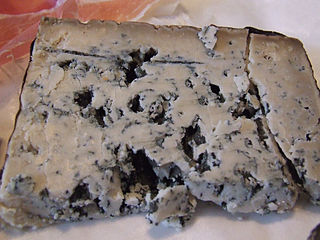
Cabrales is a blue cheese made in the artisan tradition by rural dairy farmers in Asturias, Spain. This cheese can be made from pure, unpasteurized cow’s milk or blended in the traditional manner with goat and/or sheep milk, which lends the cheese a stronger, spicier flavor.
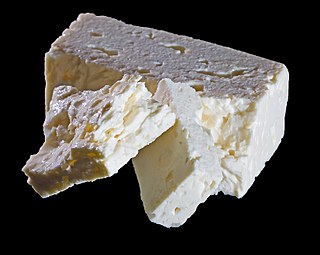
Feta is a Greek brined white cheese made from sheep's milk or from a mixture of sheep and goat's milk. It is soft, with small or no holes, a compact touch, few cuts, and no skin. Crumbly with a slightly grainy texture, it is formed into large blocks and aged in brine. Its flavor is tangy and salty, ranging from mild to sharp. Feta is used as a table cheese, in salads such as Greek salad, and in pastries, notably the phyllo-based Greek dishes spanakopita "spinach pie" and tyropita "cheese pie". It is often served with olive oil or olives, and sprinkled with aromatic herbs such as oregano. It can also be served cooked, as part of a sandwich, in omelettes, and many other dishes.
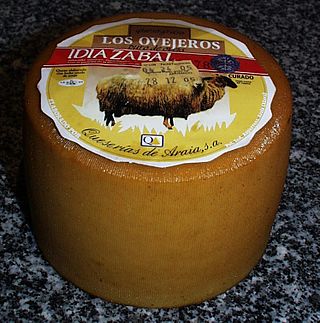
Idiazabal is a pressed cheese made from unpasteurized sheep milk, usually from Latxa and Carranzana sheep in the Basque Country and Navarre. It has a somewhat smokey flavor, but is usually un-smoked.

Dutch cuisine is formed from the cooking traditions and practices of the Netherlands. The country's cuisine is shaped by its location in the fertile North Sea river delta of the European Plain, giving rise to fishing, farming, and trading over sea, its former colonial empire and the spice trade.

Maytag blue cheese is produced on the Maytag Dairy Farms just outside of Newton, Iowa city limits.

Danablu, often marketed under the trademark Danish Blue Cheese within North America, is a strong, blue-veined cheese. This semi-soft creamery cheese is typically drum- or block-shaped and has a yellowish, slightly moist, edible rind. Made from full fat cow's milk and homogenized cream, it has a fat content of 25–30% and is aged for eight to twelve weeks.
Nøkkelost is a common, Norwegian name for kuminost, a cheese flavored with cumin and cloves. It is semi-hard, yellow, and made from cow's milk, in the shape of wheels or blocks, with a maturation period of three months.

Bergkäse refers to a number of varieties of cheese produced in the Alps. This includes products of mountain farming, the cultivation of alpine pastures as well as the milk processing of local producers in dairies. The term does not say much about the type or production method of the product called mountain cheese, which is usually a hard or semi-hard cheese with no or little holes, usually with a natural rind, but there are also semi-hard cheeses and soft cheeses under this designation. The term is used also generically for Swiss-type or Alpine cheeses, which resemble these in taste and texture but do not come from one of the traditional cheese making regions. The texture is rather hard, sometimes with small holes or cracks, the flavour strong and often a bit nutty.
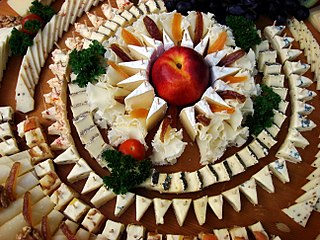
Cheese is a dairy product produced in wide ranges of flavors, textures, and forms by coagulation of the milk protein casein. It comprises proteins and fat from milk. During production, milk is usually acidified and either the enzymes of rennet or bacterial enzymes with similar activity are added to cause the casein to coagulate. The solid curds are then separated from the liquid whey and pressed into finished cheese. Some cheeses have aromatic molds on the rind, the outer layer, or throughout.

Black garlic is a type of aged garlic that is colored deep brownish-black. The process is of East Asian origin. It is made by placing garlic in a warm, moist, controlled environment over the course of several weeks, a process that produces black cloves. Black garlic is used in a wide variety of culinary applications.
Nagelkaas, also called Frisian Clove cheese, is an unprotected name variant of kanterkaas, a Dutch cheese developed in the Frisian Islands of the Netherlands. It is a firm-textured gouda-style cheese made from skim pasteurized cow's milk. Its 23% butterfat content results in a mild flavor, which is augmented with the addition of cloves and cumin for a pronounced spicy taste.

Vegan cheese is a category of non-dairy, plant-based cheese analogues. Vegan cheeses range from soft fresh cheeses to aged and cultured hard grateable cheeses like plant-based Parmesan. The defining characteristic of vegan cheese is the exclusion of all animal products.
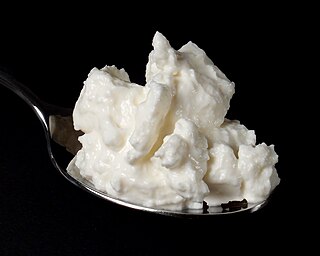
Quark or quarg is a type of fresh dairy product made from milk. The milk is soured, usually by adding lactic acid bacteria cultures, and strained once the desired curdling is achieved. It can be classified as fresh acid-set cheese. Traditional quark can be made without rennet, but in modern dairies small quantities of rennet are typically added. It is soft, white and unaged, and usually has no salt added.
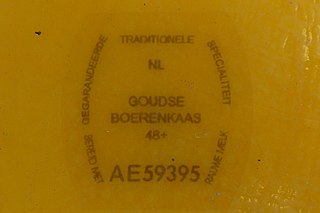
Boerenkaas is a Dutch cheese, most of which is handmade from raw milk. The milk may be from cows, goats, sheep or buffalo; at least half of it must be from the farm where the cheese is made. The cheese may also contain cumin or other seeds, herbs, and spices.














